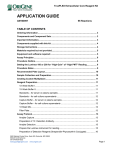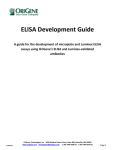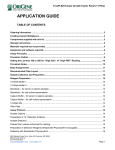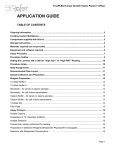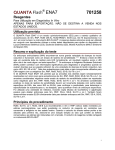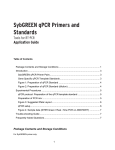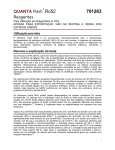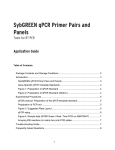Download User Manual
Transcript
TruePLEX™ Human Antibody Profiling Array Detection Kit APPLICATION GUIDE TruePLEX™ Human Antibody Profiling Array Detection Kit Part Number: AP100001 For Research Use Only For Research Use Only Rev 050613A1 www.origene.com Page 1 TruePLEX™ Human Antibody Profiling Array Detection Kit For Research Use Only Rev 050613A1 www.origene.com Page 2 TruePLEX™ Human Antibody Profiling Array Detection Kit TABLE OF CONTENTS Overview and Intended Use .............................................................................. 4 Detection of human autoantibodies with OriGene recombinant proteins..... 4 Protein source and characterization ................................................................ 4 Control Samples ................................................................................................. 5 Important Information ........................................................................................ 5 Components supplied with this kit ................................................................... 6 Storage Instructions .......................................................................................... 7 Materials required or recommended but not provided ................................... 7 Equipment and software required: ................................................................... 7 Bead Assignments and Expected Results for Control Beads ........................ 8 Setting the Luminex 100 or 200 for “High Gain” of “High PMT” Reading ..... 9 Procedure Notes................................................................................................. 9 Recommended Plate Layout ........................................................................... 10 Sample Collection and Preparation ................................................................ 10 Reagent Preparation ........................................................................................ 11 Preparation of Samples ................................................................................... 13 Assay Protocol ................................................................................................. 13 Protocol Variations .......................................................................................... 15 Protocol Summary ........................................................................................... 16 Example Data .................................................................................................... 17 Plate Template Layout ..................................................................................... 20 Plate Template Layout ..................................................................................... 20 Troubleshooting ............................................................................................... 21 For Research Use Only Rev 050613A1 www.origene.com Page 3 TruePLEX™ Human Antibody Profiling Array Detection Kit Overview and Intended Use This kit is designed for the detection and profiling of human IgG antibodies bound to Luminex xMAP™ beads. The kit should work with both the traditional polystyrene MicroPlex™ beads as well as the newer MagPlex™ magnetic beads. Human serum or plasma samples containing IgG are reacted with beads that have been covalently coupled to a native or recombinant protein, peptide, hormone, or small molecule. If the sample contains antibodies specific for the coupled entity, then these antibodies will bind to the coupled bead. After washing away the unbound material, the human IgG antibodies are detected with an anti-human IgG phycoerythrin conjugate and the bound phycoerythrin is detected in the Luminex instrument. An optimal use for this kit is for the detection and profiling of human autoantibodies. Human autoantibodies are known to play a pivotal role in many diseases including over 170 human autoimmune diseases and many cancers. Many autoantibody antigens have been identified, but others remain elusive or difficult to confirm. In addition, many questions remain unanswered regarding the role of autoantibodies in the pathology and natural history of the disease. OriGene has purified over 7000 recombinant human proteins from human cells that can be used for autoantibody testing. This kit may be used as a basic research tool for the detection of human autoimmune antibodies in serum and plasma for basic and clinical research studies. It is not intended for use in clinical diagnostics. Detection of human autoantibodies with OriGene recombinant proteins OriGene’s recombinant human proteins have been expressed and purified from a human cell line (HEK-293T). Purified proteins are then coupled to Luminex beads (available separately and by special order). Each protein is coupled to a different type or “color” of Luminex beads. A bead mix is prepared by combining antigen-coupled beads with the control beads supplied in this kit. Diluted serum or plasma is mixed with the beads and autoantibodies, if present, will bind to the specific protein-coupled beads. After washing, an anti-human-phycoerythrin conjugate is added to detect the bound human IgG. After a final wash, the samples are read in the Luminex 100 or Luminex 200 instrument. The median fluorescent intensity measured for each bead reflects the amount of human IgG bound to the bead. Protein source and characterization The proteins coupled to the Luminex beads are recombinant human proteins expressed in human cells. Thus, antibodies in serum or plasma samples may react differently to these proteins than those expressed in E. coli or insect cells due to the presence of true human post-translational modifications. For Research Use Only Rev 050613A1 www.origene.com Page 4 TruePLEX™ Human Antibody Profiling Array Detection Kit OriGene’s recombinant human proteins are expressed with a fusion tag on the Cterminus: Protein - TRTRPLEQKLISEEDLAANDILDYKDDDDKV The sequence EQKLISEEDL is known as the myc tag. The sequence DYKDDDDK is known as the DDK or FLAG™ tag. The tag sequence provides for efficient purification from the HEK cells and allows for verification that sufficient protein has been coupled to the beads. The tag sequence also provides a method for a positive control for the assay performance. Control Samples The kit contains a positive control. • The Positive Control (PC) is a concentrated antibody solution that binds to the fusion tag on OriGene’s recombinant human proteins produced from OriGene’s TrueOrf™ cDNA clones. The anti-tag antibody has been conjugated to human IgG so that it can be detected with the anti-human antibody conjugate. Important Information • Store the reagents at the temperature and condition specified on the labels. • Read the entire protocol before use • Research Use Only. The product you have received is authorized for laboratory research use only. The product has not been qualified or found safe and effective for any human or animal diagnostic or therapeutic application. Uses other than the labeled intended use may be a violation of applicable law. • Hazards. It is the end-user’s responsibility to consult the applicable MSDS(s) before using this product. Disposal of waste materials must comply with all appropriate federal, state, and local regulations. If you have any questions concerning the hazards associated with this product, please call OriGene Technologies Inc at 1-888-267-4436. • Terms and Conditions: By opening the packaging containing this Assay Product (which contains fluorescently labeled microsphere beads authorized by Luminex Corporation) or using this Assay Product in any manner, you are consenting and agreeing to be bound by the following terms and conditions. You are also agreeing that the following terms and conditions constitute a legally valid and binding contract that is enforceable against you. If you do not agree to all of the terms and conditions set forth below, you must promptly return this Assay Product for a full refund prior to using it in any manner. You, the customer, acquire the right under Luminex Corporation’s patent rights, if any, to use this Assay Product or any portion of this Assay Product, including without limitation the microsphere beads contained herein, only with Luminex Corporation’s laser For Research Use Only Rev 050613A1 www.origene.com Page 5 TruePLEX™ Human Antibody Profiling Array Detection Kit based fluorescent analytical test instrumentation marketed under the name Luminex Instrument. • Safety and Use: All biological materials should be handled as potentially hazardous. Follow universal precautions as established by the Centers for Disease Control and Prevention and by the Occupational Safety and Health Administration when handling and disposing of potentially infectious or hazardous agents. This product is authorized for laboratory research use only. The product has not been qualified or found safe and effective for any human or animal diagnostic application. Uses other than the labeled intended use may be a violation of applicable law. Components supplied with this kit Volume / Amount Part Number Positive Control (50X) 25 µL 60675 -20ºC Buffer A (Low Stringency) 20 mL 60677 4ºC Buffer B (High Stringency) 20 mL 60678 4ºC Buffer C 20 mL 60679 4ºC 1g 60680 4ºC or RT 192 µL 60681 -20ºC 2 x 12 mL 60682 4ºC Wash Buffer (20X) 50 mL 60683 4ºC Detection Reagent (50X) (Anti-Human IgG-phycoerythrin) 192 µL Component Blocking Reagent Control Bead Mix (50X) Assay Buffer E 60684 Storage Temp (ºC) -20ºC Filter Plate 1 60601 Room Temp Plate Sealers 3 60602 Room Temp For Research Use Only Rev 050613A1 www.origene.com Page 6 TruePLEX™ Human Antibody Profiling Array Detection Kit Storage Instructions • The kit is shipped on blue ice. • Store individual kit components as listed above or on the label. Materials required or recommended but not provided • Spin-X Centrifuge Tube filters, Costar # 8160 (highly recommended). • Calibrated, adjustable micropipettors with disposable plastic tips. • An 8-well multichannel pipettor is recommended but not required. • De-ionized or molecular biology grade water • Propylene tubes (1.5 ml). • Absorbent paper towels (for example, Wypall X60 from Kimberly Clark) Equipment and software required: Description Recommended Supplier / Cat. No. Luminex 100™, 200™ or equivalent Luminex, Millipore, Hitachi, Bio-Rad Microplate vacuum manifold with pressure gauge Pall Multi-well plate vacuum manifold (PN 5017). Luminex Data Acquisition Software xPONENT 3.1, Luminex IS 2.3, Luminex LDS1.7 or BioPlex Manager Vortex Mixer VWR Analog Vortex Mixer 58816-121 (120V) 58816-123 (230V) Mini centrifuge VWR Minifuge 93000-196 (120V) 93000-198 (230V) Orbital Shaker for Microplates Eppendorf Mix Mate 022674200 (120V/60Hz) 022674226 (230V/50Hz) Water Bath Sonicator Bransonic Model B3/B5 000-951-005 (Model B3, 115V) 000-951-103 (Model B5, 230V) Data Analysis Software Microsoft Excel For Research Use Only Rev 050613A1 www.origene.com Page 7 TruePLEX™ Human Antibody Profiling Array Detection Kit Control Bead Mix The Control Bead Mix contains a mixture of beads that have been coupled with certain proteins to provide assurance that the assay is working correctly. The Control Bead Mix contains beads have been coupled with the following: • Anti-human IgG: This bead binds to human IgG in serum samples and should be positive for all human serum samples. • Recombinant Human Serum Albumin: Recombinant human serum albumin is bound to Luminex beads. This bead serves as a non-specific binding control for samples and the detection antibody. This protein does not contain the myc-DDK tag. • BSA-myc-DDK: Bovine serum albumin coupled to the complete OriGene mycDDK fusion tag and then coupled to Luminex beads. This bead serves as a control for binding to the myc-DDK fusion tag sequence that is present on OriGene’s recombinant human proteins. • Donkey IgG: Donkey IgG is bound to Luminex beads. This bead serves as a non-specific binding control for samples and the detection antibody. Bead Assignments and Expected Results for Control Beads Bead Number 36 63 85 91 Description Anti-Human IgG Recombinant human serum albumin (HS Albumin) BSA-myc-DDK Donkey IgG Expected Results Epitope Tag Neg Control Pos Control Samples No Negative Positive Positive No Negative Negative Negative Yes No Negative Negative Positive Negative Negative Negative Additional beads added to the bead mix that have been coupled with OriGene’s recombinant proteins will be positive with the Positive Control. Additional beads that have been added to the bead mix that have been coupled to native proteins or proteins without a DDK fusion tag will give negative results with the Positive Control. For Research Use Only Rev 050613A1 www.origene.com Page 8 TruePLEX™ Human Antibody Profiling Array Detection Kit Note : To achieve optimal results, this kit requires the use of the “High Gain” of “High PMT” setting on the Luminex 100 or 200. Some instruments may use this setting as the default. Check with your instrument supplier for more information. Setting the Luminex 100 or 200 for “High Gain” of “High PMT” Reading 1. Create a new lot number for Cal 2 and enter it into the Luminex software as a new Cal 2 lot number (use the actual lot number with an HG at the end to designate High Gain). 2. Record the Cal 2 target value, which is usually around 3800. 3. Multiply the Cal 2 target value by 4.55 to get a new Target value of approximately 17,290. 4. Enter the new Target Value as the value for your "New" Cal 2 lot. 5. Run the Cal 2 Calibration. Procedure Notes • For preparation of all reagents, prepare enough for several extra wells to account for pipetting losses. • This kit provides sufficient reagents to run the assay at least three times. However, with careful attention to reagent preparation, additional uses may be possible. • The vacuum pressure on the vacuum manifold should not exceed 5 mm Hg. Optimal filtration occurs between 2 and 4 mm Hg. • The fluorescent beads are light sensitive and are especially sensitive to direct sunlight and incandescent light. Use aluminum foil to cover plates and tubes. Store plates in a dark location during incubations. • After vacuum filtration, blot plates on clean absorbent material such as WYPALL X60 towels from Kimberly Clark. • During loading or incubations do not place the filter plate on absorbent material as liquid will be drawn through the plate by wicking. For Research Use Only Rev 050613A1 www.origene.com Page 9 TruePLEX™ Human Antibody Profiling Array Detection Kit Recommended Plate Layout Before starting, it is recommended that a plate plan be designed. Such a plan will assist in assay workflow and data analysis. A suggested plate plan is shown below. A plate plan template is provided on page 18. 1 2 A Neg S#3 B Neg S#3 C PC S#4 D PC S#4 E S#1 S#5 F S#1 S#5 G S#2 S#6 H S#2 S#6 3 5 6 7 8 9 10 11 12 Sample Collection and Preparation 1. Serum is the preferred sample type for use in this assay. Plasma is also suitable, but non-specific binding may be increased. 2. Additional sample types may also be suitable, but have not been validated with this assay. 3. Avoid the use of lipemic of hemolyzed samples. 4. Collect samples according to standard protocols, immediately mix and separate, and then aliquot the samples into polypropylene tubes. If not tested immediately, store samples at -80ºC. 5. Analyze fresh samples as quickly as possible after collection. Allow frozen samples to thaw on ice and then mix well. Avoid multiple freeze-thaw cycles of frozen samples. 6. Optimum results are obtained when samples are clarified with a Spin-X column (Costar #8160). Add serum or plasma to the sample cup. Centrifuge at 1214,000 x g for 5-20 minutes depending upon the sample volume and the amount of particulate material in the samples. Recover the clarified sample from the bottom of the tube (the filtrate) and use immediately. 7. Turbid samples may also be clarified by centrifugation. Centrifuge samples at 14,000 x g for 10 minutes at 4°C in a refrigerated microcentrifuge immediately prior to analysis. Remove an aliquot from the supernatant taking care not to disturb any pellet and avoiding any lipid that may be floating on the top. 8. Run Controls and samples in duplicate. For Research Use Only Rev 050613A1 www.origene.com Page 10 TruePLEX™ Human Antibody Profiling Array Detection Kit Reagent Preparation 1X Wash Buffer Prepare 1X Wash Buffer by diluting the entire contents of the 20X Wash Buffer bottle with 950 ml of sterile, deionized water. For long term storage, add 0.5 g sodium azide to bring the sodium azide concentration to 0.05% (7.5 mM). Store diluted Wash Buffer at 2-8ºC. Alternatively, a portion of the 20X Wash Buffer can be diluted. Mix 1 volume 20X Wash Buffer with 19 volumes of deionized water. Sample Diluent Sample Diluent can be prepared at different stringencies. Low-stringency diluent may give higher signals but non-specific signals from some serum samples may be observed. High-stringency Sample Diluent may generate lower specific signals, but non-specific signals will be minimized. Test samples first with the High-stringency Sample Diluent. Use Moderate-stringency or Low-stringency Sample Diluent for higher sample dilutions (1:500 or greater), for samples with low antibody levels, or for samples in which the antibody affinity may be low. • Calculate the volume of Sample Diluent required. Each serum sample requires 100 µL of Sample Diluent. Additional Sample Diluent may be required to prepare intermediate dilutions and to account for pipetting losses. • Prepare Sample Diluents according to the table below. High-Stringency Sample Diluent (Recommended for initial testing) Component Buffer B Buffer C Volume per Reaction Number of Wells Final Volume 50 µL 50 µL Add 15 mg of Blocking Reagent per ml Moderate-Stringency Sample Diluent (Optional) Component Buffer A Buffer B Buffer C For Research Use Only Rev 050613A1 Volume per Reaction Number of Wells Final Volume 25 µL 25 µL 50 µL Add 15 mg of Blocking Reagent per ml www.origene.com Page 11 TruePLEX™ Human Antibody Profiling Array Detection Kit Low-Stringency Sample Diluent (Optional) Volume per Reaction Component Final Volume 50 µL Buffer A Buffer C Number of Wells 50 µL Add 15 mg of Blocking Reagent per ml • Mix Sample Diluent thoroughly by gently vortexing and place on a tube rotator while preparing the remaining reagents. Sample Diluent should appear clear before use. If Blocking Reagent is not completely dissolved, clogging of the filter plate may occur. • Do not store Sample Diluent. Prepare a fresh batch for each assay. Controls • Dilute the Positive Control (50X) into the Sample Diluent as follows: Component Sample Diluent Positive Control (50X) • Volume per Reaction Number of Wells Final Volume 98 µL 2 µL Use Sample Diluent as the Negative Control. Alternatively, dilute a known negative serum or plasma sample into Sample Diluent to create a negative control. Filter Plate Before starting the assay, cover the wells that will not be used in the assay with an aluminum plate sealer (supplied). Press sealer down so that all wells are tightly sealed. Trim edges with a razor blade. 1X Bead Mix • Multiple Bead mixes can be combined to prepare a larger multiplex. However, ensure that none of the bead regions overlap. • Briefly vortex (5 seconds) the vial of Bead Mix (50X). • Sonicate the Bead Mix (50X) for 30 seconds. • Prepare 1X Bead Mix according to the table below. Adjust volumes to account for the addition of additional beads or Bead Mixes. Prepare enough for several extra wells to account for losses during pipetting. For Research Use Only Rev 050613A1 www.origene.com Page 12 TruePLEX™ Human Antibody Profiling Array Detection Kit Component Volume per Reaction Assay Buffer E Control Bead Mix • Number of Wells Final Volume 98 µL 2 µL Mix thoroughly by gentle vortexing. Protect from light by covering tube in aluminum foil. Preparation of Samples 1. Clarify samples with a Costar Spin-X column (Costar #8160). Add serum or plasma to the sample cup. Centrifuge at 12-14,000 x g at 4ºC for 5-20 minutes depending upon the sample volume and the amount of particulate material in the samples. Recover the clarified sample from the bottom of the tube (the filtrate) and use immediately. Store excess at -20º to -80ºC. 2. Alternatively, samples may be clarified by centrifugation. Centrifuge samples at 14000 x g for 10 minutes at 4°C in a refrigerated microcentrifuge immediately prior to analysis. Remove an aliquot from the supernatant taking care not to disturb any pellet and avoiding any lipid that may be floating on the top. 3. Dilute clarified sera or plasma samples into Sample Diluent. An initial dilution of 1:200 to 1:500 is recommended. However, dilutions from 1:50 to 1:2000 may be appropriate depending upon the antibody levels in the samples. Assay Protocol IgG Binding 1. Briefly vortex the 1X Bead Mix. 2. Add 100 μl of 1X Bead Mix to each well of the filter plate. Remove liquid from the plate by gently vacuum. Blot plate thoroughly on absorbent paper. 3. Add 100 μl Sample Diluent into the Negative (blank) wells. 4. Add 100 μl of the diluted Positive Control into the PC wells. 5. Add 100 μl diluted samples into the designated sample wells. 6. Cover and incubate the plate for 1 hour at room temperature on an orbital plate shaker (600-800 rpm). 7. Fifteen minutes before the end of the incubation, prepare 1X Detection Reagent (anti-human streptavidin-phycoerythrin conjugate). Preparation of 1X Detection Reagent • Prepare 1X Detection reagent according to the table below. Prepare enough for several extra wells to account for losses during pipetting. For Research Use Only Rev 050613A1 www.origene.com Page 13 TruePLEX™ Human Antibody Profiling Array Detection Kit Component Assay Buffer E Detection Reagent (50X) Volume per Reaction Number of Wells Final Volume 98 µL 2 µL Detection of Bound IgG 1. Remove the liquid from the wells by gentle vacuum. If any of the wells have become clogged and contain residual liquid, pipette the liquid in each clogged well up and down ten times. Then continue with the washing steps below. 2. Wash beads three times by adding 100 μl 1X Wash Buffer to the wells (even if they contain residual liquid). Remove liquid with gentle vacuum. After washing, blot plate thoroughly on absorbent material. 3. Add 100 μl Detection Reagent into each well. 4. Cover and incubate the plate for 1 hour at room temperature on an orbital plate shaker at 600-800 rpm. 5. During this incubation, prepare the Luminex instrument for reading (see below). Prepare the Luminex Instrument for Reading 1. Set up the instrument as described in the user’s manual. Instruments from different vendors may have different set-up procedures. 2. Warm up the instrument. This may take up to 30 minutes. 3. Enter the analyte names and bead numbers from the Bead Mix datasheet(s). 4. Analysis Parameters: • Set the instrument to count the Total number of events. • The number of events to count should be 100 x the number of bead regions. For a mix containing 10 bead regions, the count should be set to 1000. • The minimum events setting should be 30. • The sample size should be set to 50 μL and the flow rate should be set to Fast. 5. Check the probe height and adjust it, if necessary to accommodate the filter plate 6. Perform 1 prime with sheath fluid, 1 alcohol flush, and 2 sheath fluid washes. 7. Calibrate to “High Gain” setting if necessary (see page 9). Washing and Reading 1. Wash beads three times by adding 100 μl Wash Buffer to all wells and then removing liquid with gentle vacuum. For Research Use Only Rev 050613A1 www.origene.com Page 14 TruePLEX™ Human Antibody Profiling Array Detection Kit 2. Blot plate thoroughly on absorbent material. 3. Add 100 μl 1X Wash Buffer to each well 4. Shake plate for 2 minutes on an orbital plate shaker at 600-800 rpm. 5. Read plate in the Luminex instrument. 6. If using a partial plate with unused wells remaining, remove the liquid by gentle vacuum and let the used wells dry. Mark used wells so that they are not inadvertenly used again. Data Analysis 1. Upload or transfer the Luminex data to an Excel Spreadsheet. 2. Use the Median Fluorescent Intensity (MFI) for analysis. 3. Establish a working cutoff for the specific sample population and sample dilution using the values of the controls and a set of known negative samples. Protocol Variations The following protocol variations can be utilized to increase the sensitivity or specificity of detection • Increase the IgG binding time from 60 minutes to 90 or 120 minutes. • Increase or decrease the dilution of the sample. • Alter the stringency of the binding step by using the moderate or low-stringency Sample Diluent. • Dilute the Detection Reagent (anti-human phycoerythin conjugate) to 0.5X (1:100 dilution) or 0.25X (1:200) instead of 1X (1:50). For Research Use Only Rev 050613A1 www.origene.com Page 15 TruePLEX™ Human Antibody Profiling Array Detection Kit Limitations of the Procedure 1. Plasma samples collected in anticoagulants other than sodium heparin have not been investigated. 2. The influence of drugs or other substances not usually found in serum or plasma have not been investigated. 3. The influence of abnormal (jaundiced, hemolyzed, lipemic) sera or plasma samples has not been investigated. 4. Samples with unusually low or unusually high IgG levels have not been investigated. 5. The rate of degradation of antibodies in human serum or plasma has not been investigated. 6. The affect of heterophilic antibodies on the assay has not been investigated. Protocol Summary 1. Prepare Sample Diluent, 1X Wash Buffer and 1X Bead Mix. 2. Dilute Samples in Sample Diluent. 3. Add 100 µl 1X Bead Mix to each well. 4. Remove liquid from wells by gentle vacuum. Blot thoroughly. 5. Add 100 µl of controls and diluted samples to the designated wells. 6. Cover and incubate for 1-2 hours with shaking (600-800 rpm). 7. Prepare 1X Detection Reagent. 8. Wash three times with 100 µl 1X Wash Buffer. 9. Add 100 µl of 1X Detection Reagent to each well. 10. Cover plate and incubate for 1 hour with shaking (600-800 rpm). 11. Prepare Luminex instrument for reading. 12. Wash three times with 100 µl 1X Wash Buffer. Blot thoroughly. 13. Add 100 µl of 1X Wash Buffer to each well. 14. Shake plate for 2 minutes (600-800 rpm). 15. Read in Luminex instrument. For Research Use Only Rev 050613A1 www.origene.com Page 16 TruePLEX™ Human Antibody Profiling Array Detection Kit Example Data Normal Sera The Positive and Negative Controls and fifteen normal human sera were tested with the four beads contained in the Control Bead Mix. The sera were diluted 1:200 and the assay used the high-stringency Sample Diluent and one hour IgG binding. 100000 Pos Control 10000 Neg Control Samples (15) MFI 1000 100 10 1 anti-Human HS Albumin BSA-myc-DDK Donkey IgG Control Bead Autoimmune Sera Four autoimmune sera (A1-A4) were tested with a bead mix that included six beads coupled to well-known autoimmune antigens. The sera were diluted 1:200 and the assay used the high-stringency Sample Diluent and one hour IgG binding. MFI A1 A2 A3 A4 Protein For Research Use Only Rev 050613A1 www.origene.com Page 17 TruePLEX™ Human Antibody Profiling Array Detection Kit Autoimmune Sera Dilution One autoimmune serum was tested with a bead mix containing multiple beads coupled to well-known autoimmune antigens. The serum sample was tested at a wide range of dilutions. The assay used the high-stringency Sample Diluent and one hour IgG binding. For some antigens, a strong signal (>1000 MFI) is observed even for very high dilutions. Dilution 1:100 SSB 29240 SNRPB 31492 SNRPC 27256 TROVE2 15216 SNRNP70 25684 SNRPA 13107 1:200 28927 31080 23069 10703 17202 8324 1:400 28269 30095 14371 6945 10442 4044 1:800 26488 27081 6696 4680 5490 1825 1:1600 25316 21517 3937 2588 3438 1253 1:3200 20234 11622 1860 1536 1982 486 1:6400 13619 6707 978 861 849 347 1:12800 9640 4156 516 516 572 161 For Research Use Only Rev 050613A1 www.origene.com Page 18 TruePLEX™ Human Antibody Profiling Array Detection Kit Normal Sera Twenty-five normal human sera were tested with a bead mix containing multiple beads coupled to well-known autoimmune antigens. The serum was diluted 1:200 and the assay used the high-stringency Sample Diluent and one hour IgG binding. The following results were obtained. These values can be used for guidance in developing algorithms for sample data analysis. Median Fluorescent Intensity Statistic TRIM21 SNRPA SSB TROVE2 SNRNP70 SNRPC Min 12 16 20 16 24 38 Max 197 41 57 54 215 332 Average 32 27 33 25 62 123 Median 25 26 31 23 49 97 Std. Dev. 36 8 8 9 47 77 MFI Distribution (Histogram) – Number of Samples MFI Range 0-25 TRIM21 SNRPA SSB TROVE2 SNRNP70 SNRPC 13 12 1 18 3 0 25-50 10 13 23 6 12 3 50-75 1 0 1 1 5 5 75-100 0 0 0 0 1 5 100-150 0 0 0 0 2 4 150-200 1 0 0 0 1 4 200-250 0 0 0 0 1 2 250+ 0 0 0 0 0 2 For Research Use Only Rev 050613A1 www.origene.com Page 19 TruePLEX™ Human Antibody Profiling Array Detection Kit For Research Use Only Rev 050613A1 www.origene.com H G F E D C B A 1 2 3 4 5 6 7 8 9 10 11 12 Plate Template Layout Page 20 TruePLEX™ Human Antibody Profiling Array Detection Kit Troubleshooting To troubleshoot problems with the Luminex instrument, consult the appropriate Luminex manuals, contact Luminex technical support (http://www.luminexcorp.com/support), or contact your instrument supplier. Problem Cause Solution Insufficient bead count Bead mix not prepared correctly Prepare new bead mix and re-run samples. Sonicate and vortex vial containing 50X Bead Mix. Vacuum pressure too high Adjust vacuum pressure to 2-5 mm Hg during filtration Plate leaked in the Luminex instrument See section below on “Leaking plate” Clogged sample probe Clean sample probe. Remove and sonicate, if necessary. Clogged wells Clarify samples before removing aliquot for testing. Clogged wells Pipette liquid in well up and down 10 times. The add 100 µl Wash Buffer to all wells and continue with next wash step. Plate has not made a tight seal with the vacuum manifold Replace gasket on vacuum manifold. Probe Height not adjusted correctly Adjust probe height with two alignment disks using the filter plate in the kit. Insufficient blotting of filter plate Blot filter plate thoroughly onto paper towels after each washing cycle Vacuum pressure too high Ensure that the vacuum pressure is less than 5 mm Hg. Cross-contamination of wells Pipette carefully to ensure that no material from the control or sample wells reaches the blanks (Neg) wells. Ineffective or omitted wash steps Follow wash instructions carefully. Increase number of washes if necessary. Wells in filter plate will not vacuum Leaking plate High Background For Research Use Only Rev 050613A1 www.origene.com Page 21 TruePLEX™ Human Antibody Profiling Array Detection Kit Problem Cause Solution Low signal in the controls Luminex instrument gain setting is incorrect Make sure that the reporter channel is calibrated to the “High Gain” or “High PMT” setting. 1X Detection Antibody prepared incorrectly Prepare new 1X Detection Antibody Incubations were too short, or shaking was insufficient Check assay conditions and remedy as necessary Instrument is out of calibration Recalibrate instrument. Beads are photo-bleached Protect beads from light at all times. Use amber colored tubes. Incorrect bead regions entered. Check protocol template. Correct if necessary. Beads not in region For Research Use Only Rev 050613A1 www.origene.com Page 22






















